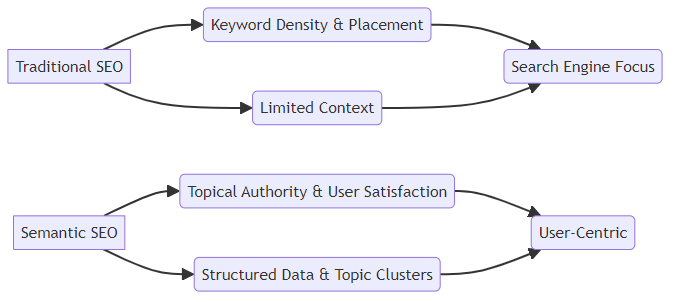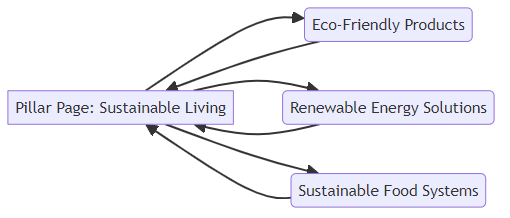Semantic SEO and AI Writing: A Comprehensive Guide for Marketers
Understanding Semantic SEO
Did you know that search engines are now smart enough to understand the intent behind your queries, not just the words you use (Do Keywords Still Matter? - Web Ascender)? This shift is all thanks to Semantic SEO, a strategy that's transforming how marketers approach content and search engine optimization.
Semantic SEO focuses on creating content around topics rather than just individual keywords (The basics of Semantic SEO and why It matters today). It's about understanding the context, user intent, and the relationships between different entities. Ilfusion Creative explains that Semantic SEO uses Natural Language Processing (NLP) to "understand the meaning behind words and phrases, rather than just relying on keywords." () This understanding is achieved through sophisticated technologies like Natural Language Processing (NLP) and vast knowledge graphs that map relationships between concepts.
- Helps search engines deliver more meaningful and relevant results, enhancing the overall user experience.
- Emphasizes understanding user intent, ensuring content aligns with what users are actually searching for. For example, if someone searches for "best lightweight hiking backpack," Semantic SEO helps search engines understand that the user is looking for backpacks suitable for hiking, not just any backpack that happens to be light.
- Focuses on the relationships between entities, allowing search engines to understand how different concepts are connected. For instance, a search for "diabetes diet" should bring up results that discuss not just food, but also related aspects like exercise and blood sugar management.
The evolution of search has been a journey from simple keyword matching to sophisticated understanding, a transition that has been significantly shaped by advancements like:
- A key turning point was the introduction of the Hummingbird Algorithm, which shifted the focus from keyword matching to understanding the intent behind user queries. seo.ai notes that Hummingbird allowed Google to assess the overall topic of a page rather than focusing on individual keywords.
- The Knowledge Graph was introduced to help search engines understand the relationships between real-world entities.
- Natural Language Processing (NLP) advancements have enabled search engines to better understand context, nuances, and the subtleties of human language.
Semantic SEO marks a significant departure from traditional SEO tactics.
- Traditional SEO primarily focuses on keyword density and placement, often leading to content that is optimized for search engines but not necessarily for users.
- Semantic SEO, on the other hand, emphasizes topical authority and user satisfaction. This means creating content that comprehensively covers a topic and provides valuable information to the reader.
- Semantic SEO also incorporates advanced techniques like structured data and topic clusters to provide context to search engines. For example, structured data (like schema markup) provides explicit labels for information on a page, telling search engines "this is a recipe," "this is a product," or "this is an event." Topic clusters, on the other hand, create a network of related content, where a central "pillar page" covers a broad topic, and supporting articles delve into specific subtopics, all linking back to the pillar. This interconnectedness helps search engines understand the depth and breadth of your expertise on a subject.

Understanding Semantic SEO is just the first step in mastering modern marketing. Next, we'll explore how AI writing tools can further enhance your SEO strategy.
The Power of AI in Semantic SEO
Did you know AI can now understand the why behind a search, not just the what? Let's dive into how AI is revolutionizing Semantic SEO, making search engines smarter and content more effective.
AI algorithms are transforming how we approach SEO by deeply analyzing data and understanding context. This shift directly influences keyword strategy by moving beyond simple term matching. Here’s how:
- AI algorithms can analyze vast amounts of data to identify semantic relationships. These algorithms sift through text, user behavior, and search patterns to uncover connections between different concepts. For example, in healthcare, AI can link symptoms to diseases, treatments, and patient outcomes, enabling more precise and relevant search results.
- NLP helps AI understand the nuances of human language and user intent. NLP allows AI to interpret the subtleties of language, including sentiment, intent, and context. This ensures that content aligns with what users are actually looking for. For instance, if a user searches for "affordable electric cars with long range," NLP helps AI understand the user wants budget-friendly EVs with extended driving capabilities.
- AI can assist in identifying related keywords and topics. AI tools can quickly generate lists of semantically related terms and topics, helping content creators build comprehensive and authoritative content. This goes beyond traditional keyword research, focusing on the broader context of a subject. For instance, AI can identify that "personal finance," "budgeting," and "investing" are related topics when someone searches for "financial planning."
Forget old-school keyword stuffing; AI is ushering in a new era of intelligent keyword strategy.
- AI tools can identify top-performing keywords based on context and relevance. These tools analyze search engine results pages (SERPs) and user behavior to pinpoint keywords that drive traffic and engagement. For example, in the retail industry, AI can identify that "eco-friendly baby clothes" performs better than "organic cotton baby apparel" among environmentally conscious parents.
- AI can classify keywords by search volume, competition, and relevancy. This classification helps marketers prioritize keywords based on their potential impact. For instance, AI can determine that while "cloud storage" has high search volume, "secure cloud storage for small businesses" has lower competition and higher relevance for a specific target audience.
- AI can predict search intent and user behavior to optimize keyword strategy. By analyzing historical data and search patterns, AI can anticipate what users are likely to search for in the future. This enables marketers to proactively optimize their content. In the finance sector, AI might predict an increase in searches for "tax-efficient investments" leading up to tax season, allowing financial advisors to create timely and relevant content.
AI writing assistants are more than just content generators; they're partners in creating semantically rich content.
- AI writing assistants can generate high-quality, semantically relevant content. These tools use NLP to understand the context of a topic and generate content that aligns with user intent. For example, an AI writing assistant can create a blog post about "sustainable fashion" that naturally incorporates related terms like "ethical sourcing," "eco-friendly materials," and "fair trade practices."
- AI can help optimize content for readability and user engagement. AI tools analyze content to ensure it's easy to read, engaging, and informative. This includes suggesting improvements to sentence structure, vocabulary, and overall flow. For instance, AI can identify and simplify complex sentences in a legal document, making it more accessible to a general audience.
- AI can ensure content aligns with search engine algorithms and user intent. AI tools continuously analyze search engine algorithms to ensure content is optimized for visibility. This includes incorporating relevant keywords, using structured data, and creating content that answers user queries comprehensively. For example, AI can analyze a webpage about "digital marketing" and suggest adding a section on "AI-driven marketing strategies" to align with current search trends.
AI's ability to enhance semantic understanding, optimize keyword research, and improve content creation makes it an invaluable asset in modern marketing strategies. Now, let's look at how to choose the right AI writing tool for your Semantic SEO needs.
Implementing Semantic SEO Strategies
Implementing Semantic SEO strategies is like giving search engines a treasure map to your content, making it easier for them to understand and reward your efforts. Let's explore some key techniques to make your content shine in the semantic web.
Did you know that organizing your content around central themes can significantly boost your SEO? Topic modeling involves using AI tools to identify key topics and subtopics related to your main content.
- Use AI to uncover main themes and subtopics within your content. For instance, if your main topic is "digital marketing," AI can reveal subtopics like "SEO strategies," "content marketing," and "social media advertising." This ensures you cover all relevant aspects.
- Create a pillar page that covers a broad topic, acting as a central hub for related content. For example, a pillar page on "sustainable living" could cover various subtopics.
- Develop supporting content that delves deeper into specific subtopics and links back to the pillar page. This creates a cohesive structure, signaling to search engines that your site offers in-depth information on a topic.

Traditional keyword research focuses on finding high-volume terms, but semantic keyword research goes deeper. It's about understanding the relationships between words and phrases.
- Explore the connections between words and phrases to align with user intent. If your primary keyword is "running shoes," related terms might include "athletic footwear," "jogging sneakers," and "trail running gear."
- Identify core topics that are relevant to your content and use keyword tools to find related terms.
- Incorporate Latent Semantic Indexing (LSI) keywords, which are terms that are semantically related to your primary keyword.
AI-powered tools can significantly streamline your Semantic SEO efforts.
- Utilize Publish7's Blog Topic Ideas Generator to discover relevant and trending topics. This tool helps you stay ahead of the curve by identifying subjects that resonate with your audience, contributing to topical authority.
- Employ the SEO Strategy Generator to create a comprehensive semantic SEO plan. This tool analyzes your content and suggests improvements to enhance its semantic relevance by identifying related topics and keywords.
- Enhance user experience with UX reviews to improve engagement and reduce bounce rates. A positive user experience signals to search engines that your content is valuable and relevant, which is a key component of semantic understanding.
- Improve organic visibility through Publish7's Backlink Ideas Generator. High-quality backlinks from reputable sources can signal to search engines that your website is authoritative and credible on a particular topic, reinforcing your semantic authority.
Implementing these strategies can transform your content from a collection of keywords to a rich, interconnected web of information. Now, let's look at how to choose the right AI writing tool for your Semantic SEO needs.
Technical Aspects of Semantic SEO
Schema markup is like giving search engines a cheat sheet, making it easier for them to understand your content. Are you ready to dive into the technical aspects of Semantic SEO?
Implementing schema markup is crucial for providing search engines with the context they need to understand your content. This involves adding specific code to your website's HTML to define the different elements on your pages. Think of it as labeling all the ingredients in a dish so that anyone can understand what's in it.
By using schema markup, you provide search engines with additional information about your content. For example, if you have a recipe, schema markup can specify the ingredients, cooking time, and nutritional information. This helps search engines display relevant information directly in search results.
Structured data enhances your visibility in search results through rich snippets. These snippets can include star ratings, reviews, images, and other details that make your search listing more appealing. For example, an e-commerce site can display product availability, price, and customer ratings directly in the search results, increasing click-through rates.
It is essential to ensure that your schema markup is accurate and relevant to your content. Inaccurate or misleading markup can negatively impact your search rankings. Regularly audit your schema to ensure it aligns with the information on your pages.

Strategic contextual linking is about placing links within your content to connect related pages. A well-structured site helps search engines understand the relationships between different pieces of content. Think of it as creating a network of interconnected ideas that guide the user and the search engine through your site.
Strategically place links within your content to connect related pages. For example, an article about "digital marketing" might include links to related topics like "SEO strategies" and "content marketing." This helps search engines understand the context and relevance of your content.
Build a logical internal link structure to improve site navigation. A clear and intuitive site structure makes it easier for users and search engines to find the information they need. This includes creating a hierarchy of pages and linking related content together.
Use descriptive anchor text to provide context to search engines. Anchor text is the visible, clickable text in a hyperlink. It should accurately reflect the content of the page being linked to. For instance, instead of using generic anchor text like "click here," use something descriptive like "learn more about AI writing tools" or "discover semantic SEO strategies." This tells both users and search engines exactly what to expect when they click the link.

As mentioned earlier, search engines are increasingly using Natural Language Processing (NLP) to understand the nuances of human language. Optimizing your content for NLP involves using conversational language, answering questions directly, and utilizing long-tail keywords strategically.
- Use conversational language in your content. Write in a way that sounds natural and engaging to your audience. Avoid using overly technical jargon or complex sentence structures.
- Answer questions directly within your content. This helps search engines identify your content as a valuable resource for users seeking answers to specific queries. Consider including a FAQ section to address common questions related to your topic.
- Utilize long-tail keywords strategically. These are longer, more specific phrases that reflect the natural way people speak. Incorporating long-tail keywords can help you attract a more targeted audience.
By mastering these technical aspects, you can significantly improve your Semantic SEO strategy. Now, let's look at how to choose the right AI writing tool for your Semantic SEO needs.
AI Writing Tools for Semantic SEO
AI writing tools are now essential for marketers aiming to boost their Semantic SEO, but how do you choose the right one? Let's explore the best approach to selecting and using these powerful tools.
Selecting the right AI writing assistant can significantly impact your content's performance. To maximize the benefits of AI in your content creation process, consider these best practices:
- Begin by using AI to generate content outlines and initial drafts. This saves time and provides a solid foundation for your content.
- Always review and edit AI-generated content to ensure accuracy and relevance. AI can provide a starting point, but human oversight is crucial for maintaining quality and brand voice.
- Incorporate your brand voice and expertise into the final content. AI should enhance, not replace, your unique perspective and insights.
While AI offers numerous advantages, it's important to be aware of potential drawbacks and use these tools responsibly.
- Always ensure content is original and free of plagiarism. Use plagiarism checkers to verify the uniqueness of AI-generated text.
- Avoid over-reliance on AI, which can lead to generic or repetitive content. Balance AI assistance with human creativity and critical thinking.
- Focus on providing unique insights and value to your audience. AI should support, not supplant, your expertise and unique perspective.
By carefully selecting and using AI writing tools, and by avoiding common pitfalls, marketers can enhance their Semantic SEO strategies and create more effective content. Now, let's delve into how to measure the success of your Semantic SEO efforts.
Measuring and Analyzing Semantic SEO Performance
Ready to see if your Semantic SEO efforts are paying off? It's not just about rankings; it's about delivering the right content to your audience.
Organic traffic growth is a primary indicator. Look for a steady increase in visitors from search engines, showing your content resonates.
Monitor keyword rankings for your target topics. Are you climbing the ranks for the phrases that matter most to your audience, including semantically related terms and topic clusters?
Analyze user engagement metrics like bounce rate and time on page. Lower bounce rates and longer session durations indicate your content is engaging and relevant.
Track SERP Feature inclusion. Getting featured in snippets or "People Also Ask" sections boosts visibility and demonstrates authority on a topic.
Use Google Analytics to track organic traffic and user behavior. It provides insights into where your visitors come from and how they interact with your site.
Leverage Search Console to monitor keyword rankings and crawl errors. This helps identify technical issues that may hinder your Semantic SEO efforts.
Employ SEO tools to analyze competitor performance and identify opportunities. Understanding what works for others can inform your strategy.
Continuously monitor and analyze performance data. Regularly review your metrics to identify trends and areas for improvement.
Adjust your content strategy and keyword targeting based on insights. Refine your approach based on what's working and what isn't.
Stay up-to-date with the latest algorithm updates and SEO best practices. Search engine algorithms evolve, so your strategy should too.
By consistently measuring and analyzing these key metrics, you can fine-tune your Semantic SEO strategy for optimal results. Let's wrap things up with a final review of Semantic SEO and AI writing.
The Future of Semantic SEO and AI Writing
Is Semantic SEO and AI writing the future of marketing? As search engines evolve, understanding these trends is crucial for staying ahead.
Semantic search is constantly evolving, driven by advancements in AI and user expectations. Keeping abreast of these trends will be critical for future SEO success.
- Increased focus on user experience and mobile optimization. Search engines are prioritizing websites that offer seamless user experiences, especially on mobile devices. Ensure your site is fast, responsive, and easy to navigate for all users.
- Growing importance of voice search and conversational AI. Voice search is becoming increasingly popular. Optimize your content to answer common questions in a natural, conversational tone.
- Integration of AI into more aspects of the search process. AI is already being used to understand user intent, generate content, and personalize search results. Expect AI to play an even bigger role in the future of search.
AI's role in content creation and optimization will only continue to grow. Embracing AI-powered tools and strategies will become essential for marketers.
- AI will continue to play a significant role in content creation and optimization. AI can assist with everything from keyword research to content generation to performance analysis. Marketers who leverage AI will be able to create more effective content in less time.
- AI will enable more personalized and targeted content experiences. For example, AI can analyze a user's past search history and on-site behavior to tailor content recommendations or even dynamically adjust content elements to better match their inferred interests, making the experience more relevant.
- Marketers will need to adapt to the evolving landscape of AI-powered SEO. As AI continues to evolve, marketers will need to stay up-to-date on the latest trends and best practices. This will require a willingness to experiment and learn new skills.
As search engines become more advanced, incorporating semantic SEO into your strategy will be crucial for staying competitive and driving relevant traffic to your website.
To prepare for the future of search, there are a few key steps you can take.
- Focus on building topical authority and providing valuable content. The best way to future-proof your SEO strategy is to create high-quality content that comprehensively covers a topic. This will signal to search engines that your site is a valuable resource for users.
- Embrace AI tools and technologies to enhance your SEO efforts. AI can help you with everything from keyword research to content generation to performance analysis. Experiment with different AI tools to see how they can improve your SEO workflow.
- Prioritize user experience and create content that meets user needs. Ultimately, the goal of SEO is to provide users with the best possible experience. Focus on creating content that is informative, engaging, and easy to use.
By focusing on these key areas, you can prepare for the next generation of search and ensure that your content continues to reach your target audience. As search evolves, a user-centric approach, combined with AI tools, will pave the way for success in the semantic web.





